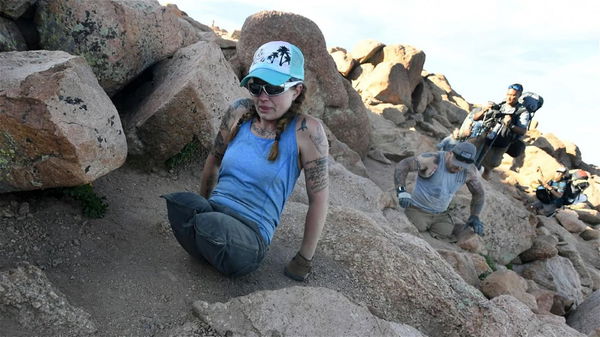

In the debate between hard work and talent, hard work is known to have edged a win more often than not. And if one is not possessed with certain abilities, hard work becomes ever more important. Such is also the case with Mandy Horvath. The 23-year-old bilateral above-knee amputee climbed Handies Peak, a 14,058 ft tall mountain, just last weekend. And yes, it was just as hard as you thought it would be. Horvath’s testimony proves as much.
Watch What’s Trending Now!
Upon reaching the peak, she dedicated her achievement to her best friend, Brian Adams, who was recently diagnosed with Acute Myeloid Leukemia (AML), a rare type of cancer. Slacker, as she fondly refers to him, is known as a person who does a lot for the community. Horvath herself has been associated with AML since losing her grandmother to the disease in 2020. So, her association with the disease and the people it has affected pushed her to do what most mortals would deem impossible, a feat details of which would scare the bravest of people.
ADVERTISEMENT
Article continues below this ad
Mandy Hovarth’s daunting journey of running up that hill
The idea was for Hovarth and her hiking partner, Robin Bridgewater, to start climbing on October 12, but they were faced with a blizzard, temperatures below the freezing point. But the duo continued and made base camp at a height of 10,000 ft. According to Hovarth, the temperature in their camp was about 20 degrees. This was Friday.
Saturday was the day they would get to the summit. But it wouldn’t be the forces of the universe being themselves if things got easier from that point on. And it wasn’t. Their team was only one of the few people on the trail, so they had to make their way through the snow. Speaking to KDVR, Hovarth claimed that she had to crawl through snow, whose depth was more than her height on her first climb in the snow.
ADVERTISEMENT
Article continues below this ad
“I crawled through sections of the trail where the snow was deeper than I was tall. This was my first time on a snow climb. Glaciers are a completely different ordeal — its ice.” She adds, “This was fresh, powdery snow, and so my arms sank about a foot down, and my tush shoveled a path on the trail.”
By the time they reached 13,500 ft, it was already 5 o’clock in the evening. There was only an hour till the sun would go below the horizon, and they would be left with about 45 minutes of light before working in pitch darkness, not to forget, the temperature purging below what it originally was.
ADVERTISEMENT
Article continues below this ad
Did Mandy Hovarth need rescuing?
At 5 p.m., she had come to the realization that it would take her another hour and 30 minutes to get to the summit. So she asked her teammate to leave her behind and rush to the top. Continuing the summit would have put both their lives in grave danger. When her partner reached the summit, she found out that people had been looking for the pair, thinking they were lost.
They were in fact, not lost. Not just that, they had enough provisions to last them for a fortnight. This search made Hovarth unhappy, who calls it ableist behavior.
Since recuse is only called for able-bodied people who have no emergency supplies and gear with them, the 23-year-old felt that the rescue had been called preemptively. She said that she had never climbed a mountain in under 3 days so, the rescue was definitely premature. So, what happened to the climb?
Did she reach the summit?
This was but a trial run. Hovarth managed to descend 4.5 miles in a record time of less than 3 hours, which was unfortunate, one could say, as she was just shy of the peak. Speaking after the event, Hovarth said that if they didn’t have the confidence or the experience to climb the mountain, they wouldn’t have been there in the first place.
Some other day, perhaps. And it wouldn’t be surprising if that day was sometime in the near future. Hovarth has already climbed the Peaks Pike twice. And next year, she plans to make a journey to the fascinating Mount Kenya. Hopefully, she gets to do that without the whole world being on the lookout for her.
The world is inherently built against differently-abled people. More often than not, despite people’s best intentions, acts borne out of goodwill can come off as patronizing. And that is the last thing a differently-abled person needs. What do you think? Let us know in the comments.
Watch this story: VIDEO: Brave Female Officer Neutralizes Bar Disturbance With UFC-Style Strikes
ADVERTISEMENT
ADVERTISEMENT
ADVERTISEMENT
ADVERTISEMENT


